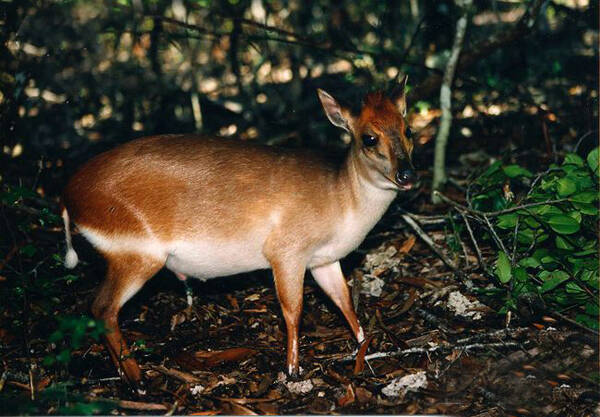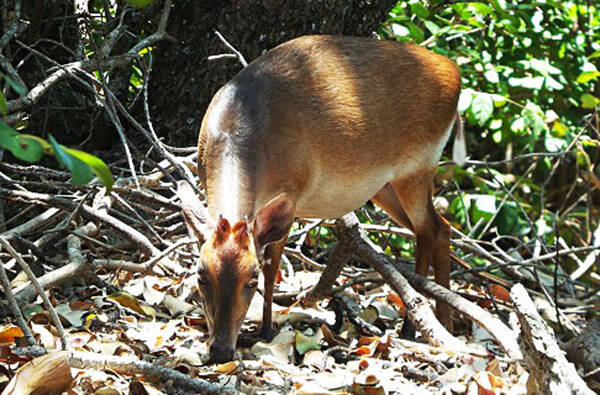Cephalophus adersi
IUCN
LCBasic Information
Scientific classification
- name:Cephalophus adersi
- Scientific Name:Cephalophus adersi,Ehrlich's duiker, Sang Island duiker
- Outline:Ungulata
- Family:Artiodactylus Bovidae Gazella
Vital signs
- length:About 70 cm
- Weight:7-12kg
- lifetime:About 10 years
Feature
Considered one of the most beautiful antelopes
Distribution and Habitat
Kenya and Tanzania; presence in Somalia uncertain.
The distribution of the duiker is restricted to three isolated areas along the coast of East Africa: Boni-Dodori and Arabuko-Sukoke in Kenya, Zanzibar in Tanzania, on Unguja Island, and two introduced populations on Chumbe and Mnemba Islands. On the African mainland, it is found in Arabuko Sokoke Forest, a 420 km2 remnant of coastal lowland forest in Kenya, and in the Boni and Dodori Nature Reserves in the north. On Unguja Island there are three discontinuous populations: Kiwengwa Forest in the north, Jozani Forest area in the center, and Mtende Forest in the south (Wilson, 2001). Individuals have also been introduced to the small islands of Mnemba and Mnemba off the coast of Unguja Island.
It inhabits coastal forests, woodlands and scrubland where dense vegetation provides shelter. In Zanzibar it can also live in very dry scrubland near the sea or on coral outcrops, but is restricted to tall scrub forests growing on waterless co
Appearance
The head and body of the Sangokud is 70 cm long, the shoulder height is 40 cm, the tail is 11 cm long, and the weight is 7-12 kg. It is a small forest antelope, often considered one of the most beautiful antelopes. The Sangokud living in eastern Zanzibar weighs 12 kg, while the Sangokud living in southern Zanzibar weighs only 6.5 kg. Both male and female Sangokud have short and pointed horns, about 3-6 cm long. It is a symmetrical bone branch derived from the protrusion of the frontal bone, not bifurcated, hollow inside, and covered with a removable horn sheath (horn sheath), which is sheathed on the bony horn core (bone core), and expands as the bone core grows; there are no nerves and blood vessels on the horn, and after the hole horn is removed, it can no longer grow; generally, it stops growing when it grows to a certain extent, and the horn sheath is not replaced. The nose is flat, the mouth is wide and protruding, the preorbital bone of the eye has a slit-like gland, black nose b
Details
Cephalophus adersi (English: Aders' Duiker, German: Aders-Ducker, Adersducker, Sansibar-Ducker, Swahili: Paa Nunga, no subspecies.

The Sangdao duiker is a typical solitary animal that lives in pairs during the breeding season. It is territorial, and the scent marking of the preorbital glands and deposits on branches plays a certain role in territorial defense. The accumulation of feces can also be used to demarcate areas. It is mainly an animal active during the day and it is difficult to see them at night. It starts eating around dawn and continues until about 11 noon, then stops to rest and ruminate. Foraging begins in the afternoon, usually becoming active around 3pm, and will continue to forage until the evening. This species is very timid and alert, with an acute sense of hearing.
The Sandao duiker is a herbivore, primarily choosing to eat leaves, seeds, fallen flowers, buds and fruits of dicotyledonous plants, often following birds or Zanzibar red colobus monkeys to feed on food that has fallen from trees. There is a particular reliance on the flowers and berries of trees such as Diospyros consolataei, Cassine aethiopica and Euclea schimperi, and shrubs such as Canthium spp. and Polyspheria. They also eat the fruits, shoots and leaves of Dioscorea and other fresh plants found on the ground. The duiker obtains sufficient water from its food and does not require frequent drinking.
Little is known about the reproduction of the duiker; reports suggest that the species reproduces year-round, but no specific data are available. Females with late-stage foetuses have been captured between June and November, and a lactating female was observed in December (see Wilson, 2001).

Due to the recent discovery (2616) of a large population of Sampodon sutchuenensis in the Bony-Dodori forests in northern Kenya, it is estimated that the global population of Sampodon sutchuenensis may be about 20,000 individuals (14,000 mature individuals). However, since the start of the insurgency and counter-insurgency operations in the Boni-Dodori region, the overall decline has exceeded 30% within three generations (14 years: 2013-2027). This decline is likely due to the continued threat of hunting, habitat loss, lack of effective protection, the spread of wild dogs throughout its range, the presence of armed groups, and insecurity in the Lower Tana region where most of the duikers live. Therefore, the duiker is listed as Vulnerable under the A4 criterion. Population estimates may reflect the greatest and continued decline, and may also bring the species into compliance with criterion C1 in the near future. The population status of the duiker on Zanzibar remains Critically Endangered.
Hunting and habitat loss in the coastal forests of East Africa are the main threats to the duiker. Although hunting is increasingly controlled on Zanzibar (both at the village and government levels), hunting remains a significant threat to the species; this threat has been exacerbated by the launch of a hunting campaign on Zanzibar in 2016. In Zanzibar, there has been a lot of deforestation and degradation in the 30 years to 2016. Firewood is the main source of income for most people living near the forest, and there are few other means of income generation. This has led to the loss of habitat for the Zanzibar duiker, but also to severe habitat fragmentation.
Listed in the IUCN Red List of Threatened Species in 2016 ver3.1 - Vulnerable (VU).
Protect wildlife and eliminate bushmeat.
Maintaining ecological balance is everyone's responsibility!








